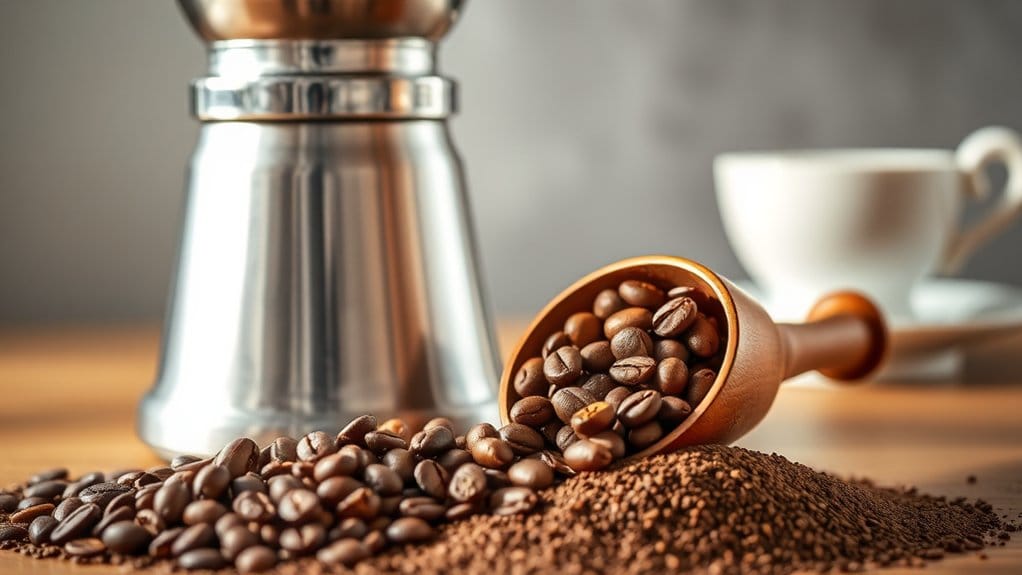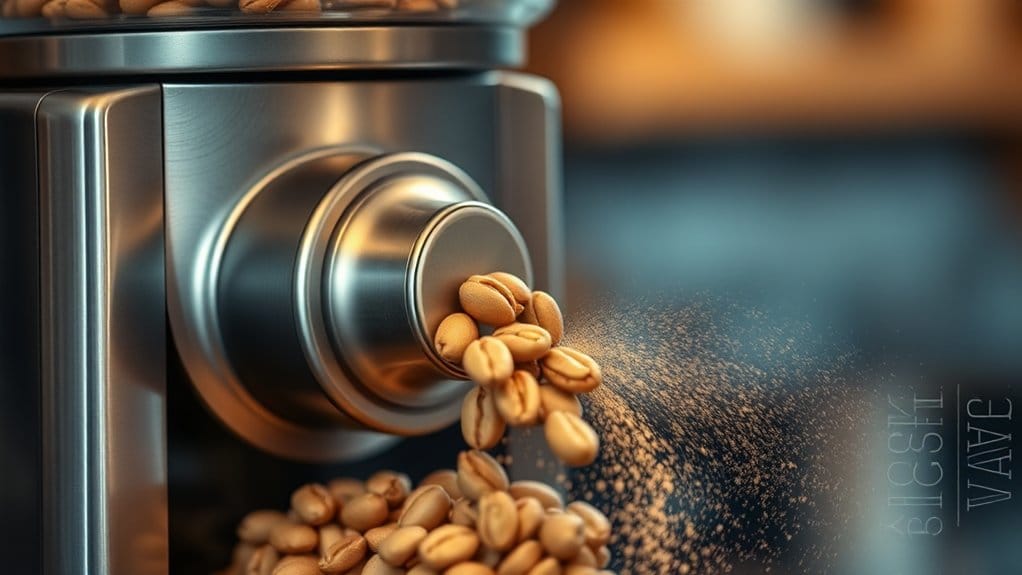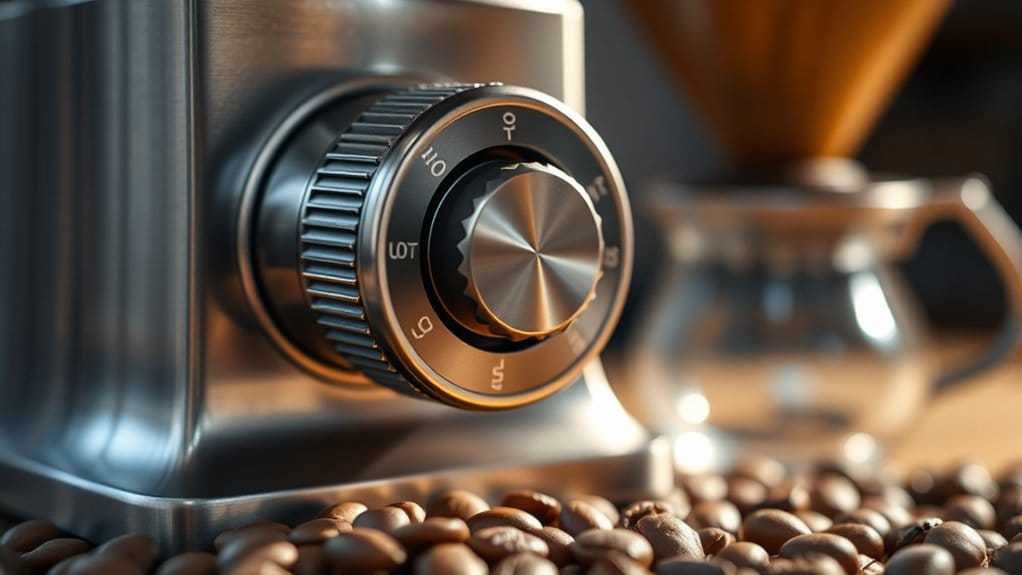Physical Address
304 North Cardinal St.
Dorchester Center, MA 02124
Physical Address
304 North Cardinal St.
Dorchester Center, MA 02124

When you’re grinding light roasts, aim for a medium to medium-fine setting, especially for pour-overs. Light roasts shine with bright, fruity notes, so a coarser grind might dampen those flavors. Think of it like balancing a rhythm! Too fine can lead to bitterness—yikes. Test your grind by tasting; if it’s sour, go finer, and if it’s bitter, coarser is your friend. Interested in perfecting your coffee game even more? There’s more to uncover!

In relation to light roasts, think of them as a delightful canvas for flavor. These beans, roasted between 350°F and 410°F, boast a brilliant taste, often floral or fruity. You might notice their light brown color and dry, matte surface—no oily sheen here! By stopping right after the “first crack,” roasters preserve the beans’ natural character. You’ll find a lively acidity that sways on your palate and a delicate body that feels invigorating. Imagine sipping a cup from Ethiopia or Kenya, tasting minerals and fruits that tell a story of their origin. Additionally, these roasts can have slightly more caffeine compared to darker varieties, enhancing their vibrant qualities. Light roasts capture the true essence of the bean, allowing you to enjoy its unique personality. Notably, they retain more caffeine due to their shorter roasting time, making them perfect for an energetic start to your day. Isn’t that a delightful way to wake up?
Finding the perfect grind size for your light roast coffee can feel like a bit of an adventure, but don’t worry—it’s easier than it sounds!
For espresso, aim for a grind size like fine table salt, around 180 to 380 microns, to unlock those delicate flavors. Coffee grind sizes vary significantly across different brewing methods, making it essential to select the right one for optimal extraction. This is crucial because freshly ground coffee maximizes flavor extraction and enhances the overall coffee flavor experience.
Using a medium grind for pour-overs, similar to granulated sugar, lets water flow just right for balanced extraction.
Drip coffee benefits from a medium-coarse grind, about the texture of sea salt, to avoid bitterness.
If you’re brewing with a French press, go coarse, like large salt grains, to keep things bright, allowing for time-consuming flavor development that enhances your cup.
And for cold brew, extra coarse is the name of the game, resembling cracked peppercorns.
Happy brewing!

When you’re grinding light roast coffee, understanding the bean’s density and humidity can make all the difference. Light roasts are denser and harder to grind because of their retained dampness. This means you’ll often need to grind them finer to get the best flavor extraction. Using a high-quality grinder with sharp burrs is crucial. It’s like having a trusty knife in the kitchen; it makes all the difference! Additionally, achieving the right grind size can maximize the coffee particles’ surface area, leading to better extraction.
Plus, beans from higher altitudes can be even denser, adding another layer to your grinding adventure. Remember, just like cooking, experimenting with different settings can lead to delicious results. So, don’t hesitate to adjust based on your beans’ unique characteristics to brew that perfect cup!
Happy grinding!
Balancing extraction for light roasts means finding that sweet spot between grind size and brewing method.
You’ll need to contemplate finer grinds, which unlock bright, floral notes by increasing surface area and speeding up extraction. Just don’t go too fine, or you might end up with a bitter cup that feels as harsh as a rainy day.
Coarser grinds, although cleaner, can under-extract your coffee, making it taste thin or sour. Think of it like an orchestra: each grind size plays its own note.
A medium-fine grind typically works best for brewing methods like pour-over, whereas espresso requires a finer touch. Proper grind sizes are crucial for different brewing techniques, impacting the overall flavor experience.
Keep experimenting, and soon you’ll brew the perfect cup that performs on your taste buds!

Have you ever noticed how unlocking the perfect cup of light roast coffee can feel like a delightful treasure hunt?
To find that gem, start with a medium to medium-fine grind for pour-over. If you’re brewing espresso, go for a fine grind.
After your first brew, savor the flavor. If it’s sour, your grind may need to be finer. If it’s bitter, try coarser. Remember, adjust one click at a time—patience is key!
Keeping a log of your settings can help you track what works. Additionally, don’t forget that water temperature, brew time, and coffee freshness play a part too. Spraying your beans lightly before grinding can significantly reduce static electricity and improve overall grind consistency.
Experiment, taste, adjust, and soon, you’ll uncover your perfect cup! Enjoy the adventure!
Humidity affects grind size by altering bean dampness content. In humid conditions, you’ll find beans become pliable, so a coarser grind helps prevent over-extraction, whereas low humidity leads to brittle beans requiring finer adjustments.
No, you can’t use the same grind for all light roasts. Bean variability affects density and extraction. Adjust your grind based on each batch’s unique characteristics and your chosen brewing method for best flavor.
To measure grind consistency accurately, you should use tools like the KRUVE BREWLER, coffee grind apps, and digital scales. These instruments help you analyze grind size, ensuring precision and improving overall coffee quality.
You should clean your grinder every two weeks for ideal performance. If you use it daily or with oily beans, consider weekly cleanings. For infrequent use, extend the interval, but stay attentive to grind quality.
You’ll want to contemplate brands like Baratza for consistency, Eureka for powerful performance, or Timemore for budget-friendly options. Each excels in delivering the grind quality crucial for appreciating light roast flavors.